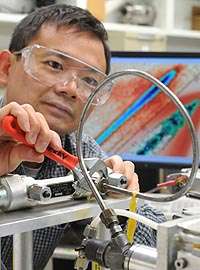Argonne physicist Jin Wang makes adjustments to a machine used for examining high speed jets at the Advanced Photon Source.
(PhysOrg.com) -- Shock waves are a well tested phenomenon on a large scale, but scientists at the Argonne National Laboratory and their collaborators from Wayne State University and Cornell University have made a breakthrough that reveals the interaction between shockwaves created by high-pressure supersonic fuel jets.
Shockwaves have been studied in the past by such methods as solid impacts and shock generators, but the high-pressure liquid jets created by micrometer sized nozzles can also reach supersonic speeds.
"Shock waves occur in nature and have been studied for many years, but it has been difficult to examine the internal structure of shock waves created by high-pressure fuel jets," Argonne scientist Jin Wang said. "High-intensity X-rays can penetrate the normally opaque jet stream allowing us to see the spray's internal structure and the gaseous environment around the jet, where the shock waves are generated.
Due to the supersonic spray's opaque nature, scientists have been unable to examine the internal structure of these jets and that has limited the improvement of high-pressure and high-speed jets and spray technologies, which are essential for numerous industrial and consumer applications, such as fuel combustions in engines, paint sprays, and industrial sprays. Using high-intensity X-rays created by the Advanced Photon Source and the Cornell High Energy Synchrotron Source at Cornell University, the scientists were able to examine the interaction between the shockwaves and liquid jets with a time resolution of one-millionth of a second. The scientists made the breakthrough by also developing a complex fluid dynamics simulation to understand the experimental observation of such a dynamical event.
In the case of fuel sprays for a combustion engine, such a transient interaction can affect fuel breakup and thus combustion efficiency and emissions. Researchers have quantitatively characterized the dynamic behaviors of the shock waves and shown that this combined experimental and computational approach can be applied to the fluid dynamics of many other systems including shock-wave-induced microbubble jetting, primary breakup modeling and cavitating flows.
The unique insights provided by the simulations were validated with time-resolved x-radiograph experiments. Because understanding the complex multiphase flow occurring in shock wave/fuel jet is extremely difficult, the agreement shown between the multiphase simulations and the experimental data provides an understanding of jet-gas interactions that has not been possible.
More information: A research article reporting this study can be seen in Physical Review Letters.
Source: Argonne National Laboratory




















